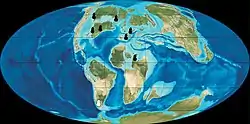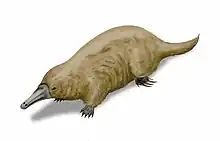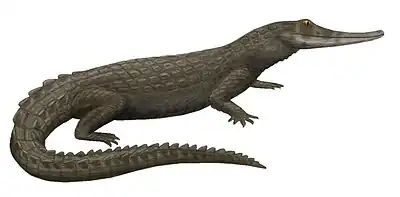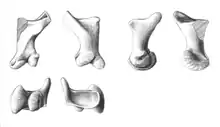Griman Creek Formation
The Griman Creek Formation is a geological formation in northern New South Wales and southern Queensland, Australia whose strata date back to the Albian-Cenomanian stages of the mid-Cretaceous.[1] It is most notable being a major source of opal, found near the town of Lightning Ridge, New South Wales. Alongside the opal opalised fossils are also found, including those of dinosaurs and primitive monotremes.[2]
| Griman Creek Formation | |
|---|---|
| Stratigraphic range: late Albian-early-mid Cenomanian ~ | |
| Type | Geological formation |
| Unit of | Rolling Downs Group |
| Sub-units | Coocoran Claystone & Wallangulla Sandstone Members |
| Underlies | Unconformity with Oligo-Miocene Cumborah Gravel |
| Overlies | Surat Siltstone, Wallumbilla Formation |
| Thickness | Up to 345 m (1,132 ft) |
| Lithology | |
| Primary | Sandstone, siltstone, mudstone |
| Other | Conglomerate, coal |
| Location | |
| Coordinates | 29.4°S 147.7°E |
| Approximate paleocoordinates | 64.4°S 134.9°E |
| Region | |
| Country | |
| Extent | Surat Basin |
| Type section | |
| Named for | Griman Creek |
| Named by | Reiser |
| Year defined | 1970 |
 Griman Creek Formation (Australia) | |
Description
As a whole, the formation primarily consists of thinly bedded medium to fine sandstone, siltstone and mudstone, with sporadic coal seams. In the vicinity of Lightning Ridge, it is divided up into two informal members the underlying Wallangulla Sandstone Member which primarily consists of red fine grained sandstone, light siltstone and grey claystone and is up to 30 metres (98 ft) thick while the overlying Coocoran Claystone consists of about 10 metres of claystone. The contact between the two units is sudden and unconformable. Discontinuous clay lens beds within the Wallangulla Sandstone Member near Lightning Ridge, referred to as the Finch Clay Facies, are one of Australia's primary sources of commercial precious opal, with many mines dug in the area. These deposits are also the primary source of fossils within the formation, a large proportion of which are preserved as semi-precious opalized pseudomorphs. The fauna found in lightning ridge indicates that the depositional environment of the Finch Clay Facies was in near-coastal freshwater lagoons.[1]
Background

GPlates reconstruction for 100 Ma (Albian-Cenomanian and Early and Late Cretaceous boundary)

Original map by Ron Blakey
Fossil content
Indeterminate avialan, euornithopod, and sauropod remains that were once misidentified as brachiosaurid are present in New South Wales, Australia.[2] Euornithopod tracks are also present in New South Wales.
Dipnoi
| Dipnoi of the Griman Creek Formation | |||||
|---|---|---|---|---|---|
| Taxa | Species | Presence | Material | Notes | Images |
| Metaceratodus wollastoni[3] | M. wollastoni | Isolated tooth plates | |||
| Ceratodus diutinus[3] | C. diutinus | Isolated tooth plates | |||
| Neoceratodus potkooroki[4] | N. potkooroki | Isolated tooth plates | |||
Actinopterygii
| Actinopterygians of the Griman Creek Formation | |||||
|---|---|---|---|---|---|
| Taxa | Species | Presence | Material | Notes | Images |
| Calamopleurus?[4] | sp. | Isolated jaw bones | |||
Mammals
| Mammals | ||||
|---|---|---|---|---|
| Genus | Species | Presence | Notes | Images |
| Kollikodon | K. ritchiei | |||
| Steropodon | S. galmani |  | ||
| Stirtodon | S. elizabethae | |||
Crocodyliformes
| Crocodyliformes | ||||
|---|---|---|---|---|
| Genus | Species | Presence | Notes | Images |
| Isisfordia | I. molnari | Lightning Ridge | Braincase and referred maxillary fragment[5] |  |
Dinosaurs
Indeterminate ornithopods and iguanodontians are known from the formation.[6] Indeterminate avetheropods and megaraptorans are known from the formation.[1] Two species of titanosauriforms and one species of titanosaur are known from teeth.[7]
| Dinosaurs | ||||
|---|---|---|---|---|
| Genus | Species | Presence | Notes | Images |
| Fostoria | F. dhimbangunmal | New South Wales | A member of Rhabdodontomorpha. | |
| Fulgurotherium | F. australe | New South Wales | [2] | |
| Rapator | R. ornitholestoides | New South Wales | A megaraptoran; "Manual element"[2][8] |  |
| Walgettosuchus | W. woodwardi | New South Wales | "Vertebra"[2][9] Later determined to be an indeterminate theropod[2] |
 |
| Weewarrasaurus | W. pobeni | New South Wales | An ornithopod known from an isolated dentary[6] | |
| Ankylosauria | Indeterminate | Osteoderm[10] | ||
| Enantiornithes | Indeterminate | Partial femora | ||
| Megaraptora ("Lightning Claw") | Indeterminate | New South Wales | Partial skeleton including parts of the lower arm, claws, lower leg, part of the hip, and pieces of ribs.[11] | |
| Noasauridae | Indeterminate | Cervical vertebra[12] | ||
| Sauropoda | Indeterminate | A tooth |
||
Pterosaurs
| Pterosaurs | ||||
|---|---|---|---|---|
| Genus | Species | Presence | Notes | Images |
| Anhangueria | Indeterminate | "two isolated tooth crowns", possible limb elements | ||
See also
- List of dinosaur-bearing rock formations
- South Polar region of the Cretaceous
- Western Interior Seaway
- Cenomanian-Turonian extinction event
- Cenomanian formations
- Australia
- Winton Formation, fossiliferous formation in Queensland
- Molecap Greensand, fossiliferous formation in Western Australia
- South America
- Alcântara Formation, fossiliferous formation of the São Luís-Grajaú Basin, Brazil
- Candeleros and Lisandro Formation, fossiliferous formations of the Neuquén Basin, Argentima
- Cerro Fortaleza and Mata Amarilla Formation, fossiliferous formations of the Austral Basin
- Chipaque Formation, Cenomanian-Turonian source rock formation of the Altiplano Cundiboyacense and Llanos Basin, Colombia
- Kem Kem Beds, Cenomanian Lagerstätte in Morocco
- Echkar Formation, fossiliferous formation of the Iullemmeden Basin, Niger
- North America
- Europe
- Cambridge Greensand, fossiliferous formation in England
- Asia
- Burmese amber
- Sannine Formation
- Khodzhakul Formation, fossiliferous formation in Uzbekistan
References
- Bell et al., 2019
- Weishampel et al., 2004, pp.573-574
- Kemp, A. (1997). "Four species of Metaceratodus (Osteichthyes: Dipnoi, Family Ceratodontidae) from Australian Mesozoic and Cenozoic deposits". Journal of Vertebrate Paleontology. 17 (1): 26–33. doi:10.1080/02724634.1997.10010949. ISSN 0272-4634. Wikidata Q104114935.
- Rodney W. Berrell, Lionel Cavin, Kate Trinajstic, Catherine Boisvert, Elizabeth T. Smith, The first record of amiid fishes (Halecomorphi, Amiiformes, Amiidae, Calamopleurini?) from Eastern Gondwana, Cretaceous Research, 2023, 105538, ISSN 0195-6671, doi:10.1016/j.cretres.2023.105538.https://www.sciencedirect.com/science/article/abs/pii/S0195667123000666
- Hart et al., 2019
- Bell et al., 2018
- Frauenfelder et al. 2020
- "Table 4.1," in Weishampel et al., 2004, p.74
- "Table 4.1," in Weishampel et al., 2004, p.78
- Bell et al., 2017
- Bell et al. 2016
- Brougham et al., 2020
- T-Bone Extension, Coocoran Opal Fields at Fossilworks.org
- Smith et al., 2013
- Smith, Elizabeth T. (September 2010). "Early Cretaceous chelids from Lightning Ridge, New South Wales". Alcheringa: An Australasian Journal of Palaeontology. 34 (3): 375–384. doi:10.1080/03115518.2010.488117. ISSN 0311-5518. S2CID 129726482.
Bibliography
- Frauenfelder, Timothy G.; Nicolàs E. Campione; Elizabeth T. Smith, and Phil R. Bell. 2020. Diversity and palaeoecology of Australia's southern‐most sauropods, Griman Creek Formation (Cenomanian), New South Wales, Australia. Lethaia 54(3). 354-367. Accessed 2020-11-09.
- Brougham, Tom; Elizabeth T. Smith, and Phil R. Bell. 2020. Noasaurids are a component of the Australian 'mid'-Cretaceous theropod fauna. Scientific Reports 10(1). 1428. Accessed 2020-01-29. doi:10.1038/s41598-020-57667-7 ISSN 2045-2322
- Bell, Phil R.; Federico Fanti; Lachlan J. Hart; Luke A. Milan; Stephen J. Craven; Thomas Brougham, and Elizabeth Smith. 2019. Revised geology, age, and vertebrate diversity of the dinosaur-bearing Griman Creek Formation (Cenomanian), Lightning Ridge, New South Wales, Australia. Palaeogeography, Palaeoclimatology, Palaeoecology 514. 655–671. Accessed 2020-01-29. doi:10.1016/j.palaeo.2018.11.020
- Hart, Lachlan J.; Phil R. Bell; Elizabeth T. Smith, and Steven W. Salisbury. 2019. Isisfordia molnari sp. nov., a new basal eusuchian from the mid-Cretaceous of Lightning Ridge, Australia. PeerJ 7. e7166. Accessed 2020-01-29. doi:10.7717/peerj.7166ISSN 2167-8359 PMC 6590469 PMID 31275756
- Bell, Phil R.; Matthew C. Herne; Tom Brougham, and Elizabeth T. Smith. 2018. Ornithopod diversity in the Griman Creek Formation (Cenomanian), New South Wales, Australia. PeerJ 6. e6008. Accessed 2020-01-29. doi:10.7717/peerj.6008 PMID 30533306 PMC 6284429
- Bell, Phil R.; Michael E. Burns, and Elizabeth T. Smith. 2017. A probable ankylosaurian (Dinosauria, Thyreophora) from the Early Cretaceous of New South Wales, Australia. Alcheringa: An Australasian Journal of Palaeontology 42(1). 120–124. Accessed 2017-10-23. doi:10.1080/03115518.2017.1384851 ISSN 0311-5518
- Bell, Phil R.; Andrea Cau; Federico Fanti, and Elizabeth T. Smith. 2016. A large-clawed theropod (Dinosauria: Tetanurae) from the Lower Cretaceous of Australia and the Gondwanan origin of megaraptorid theropods. Gondwana Research 36. 473-487. Accessed 2020-11-09.
- Smith, Elizabeth T, and Benjamin P. Kear. 2013. Spoochelys ormondea gen. et sp. nov., an Archaic Meiolaniid-Like Turtle from the Early Cretaceous of Lightning Ridge, Australia. Morphology and Evolution of Turtles Brinkman, Donald B.; Holroyd, Patricia A.; Gardner, James D.. 121–146. Accessed 2019-10-04. doi:10.1007/978-94-007-4309-0_9 ISBN 9789400743083
- Weishampel, David B.; Peter Dodson, and Halszka Osmólska (eds.). 2004. The Dinosauria, 2nd edition, 1–880. Berkeley: University of California Press. Accessed 2019-02-21. ISBN 0-520-24209-2